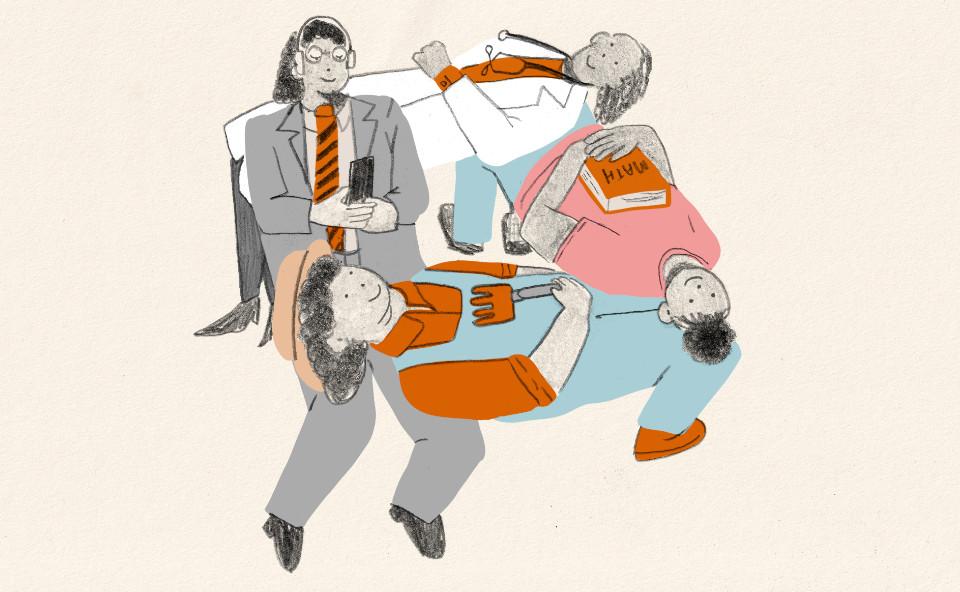
Original illustration by Gustavo Nascimento. Creative Commons BY-NC-SA.
We are about to close the second year of a life-changing global pandemic and have been recently advised of a new variant of the COVID-19 virus, Omicrom, that threatens to bring new episodes of lockdown, border shutting and supply-chain scarcity. However, today many communities, especially in the global South, have found the determination, collective intelligence and support to lead their own resilience efforts.
There are a number of lessons the world has learned, or could have learned, from this crisis, that will hopefully encourage more consciousness among human beings, rulers and communities. Lockdown brought more time to think and reflect on the question of what really matters, what should our priorities be and how can humanity (and states for that matter) catalyse strategies, systems and policies that by design are inclusive, fair and sustainable. What kind of immediate actions can communities trigger to become more resilient and to avoid replicating exclusionary norms and behaviors that hinder cohesion?
Across all these tough reflection exercises I noticed a constant factor: the active presence of women, feminist principles and diverse groups. An increasing leadership founded on questioning the status quo, embedding inclusion, diversity, innovation, fairness and collaboration at the community and local level.
This GenderIT issue is about this powerful presence and disruptive action. The involvement of women, not only men, is essential to lead change for all: children, adults and the elderly, Indigenous, native and quilombola groups reinventing community life.
The involvement of women, not only men, is essential to lead change for all: children, adults and the elderly, Indigenous, native and quilombola groups reinventing community life.
Inequality and exclusion have existed for centuries in the global South, but the COVID-19 pandemic increased their visibility. The need for social and digital infrastructures to collectively and locally resist adversity during lockdown, in situations where states and markets could not deliver basic services, digital access, healthcare or education, further mobilised communities to build their own and to start by reorganising themselves.
In Vale do Ribeira, São Paulo, Brazil, for example, a group of ecological, quilombola farmer women, in partnership with two feminist organisations: APC and Sempreviva Organização Feminista (SOF), managed to deploy and operate their Wi-Fi mesh network, as Bruna Zanolli narrates beautifully, highlighting the importance of building trust, empathy and feminist guidelines in the community so that their internet infrastructure could contribute to creating resilience and not only access to communications and information to the quilombola families.
Crises trigger fear, uncertainty, heartbreaking losses, lack of confidence and sometimes conflict. They are also a good opportunity to let go, to innovate and question everything; to unite and reprioritise the whats and the hows and questions of where and to whom resources should go first.
Attachment to predatory systems, paradigms, practices and language is holding us back from fair, inclusive and sustainable living. Marcela Guerra shakes us through her tarot card “The Tower”, raising awareness of the urgent need for a fresh start, for human-centred societies and infrastructures, or perish as Mother Nature agonises, and inequalities are exacerbated. In Marcela’s own words:
The collective intelligence acquired in the practice of community processes is the great learning experience among technologies that promote individuality. For this we do not depend on routers, satellites, nor fiber optic cables, we are essentially dependent on the networks we weave between us.
Upasana Bhattacharjee further builds on this notion of community network, not only as a local connectivity infrastructure serving the unserved people and rural areas left out by markets or states, but mainly as a social actor that builds knowledge, autonomy and agency at a local level, through a community-owned infrastructure and organised operation. This requires advocating for enabling policies, technical and managerial training, access to some form of capital, and good governance. Networks that enable people to shift from consumers to producers and creators by active involvement in the community project, may put community members in a better position to hack crises and find fit answers and measures to local challenges.
Good evidence of that agency is what has been achieved by Murambinda Works in Zimbabwe. It has been able to connect 108,000 people in North Buhera. In spite of the fact that 68% of all the population in Zimbabwe lives in rural areas, only 35.62% of them have digital access. How have farmers, high school and nursery students benefited from this community network and how has it attracted so many resources from different partners and stakeholders? Don´t miss Miami Chirilele’s story on how Murambinda is hacking the crisis bottom-up!
We are not naïve or simplistic though, we know that we still have a long way to go to close the digital divide and the gender digital gap for ever. Sarbani Banerjee Belur and Ingrid Brudvig remind us that there is no such a thing as “input access and output women empowerment”, absent education and training of all genders; affordable, meaningful and safe devices and platforms, relevant content and efficacious mechanisms to prevent violence against women and girls.
Actually, the gender inequality odyssey has to address every single form of power imbalance between men and women whether at home, work, government, politics, academia, media and civil society. Such imbalances have been replicated in the digital world, media and the new disruptive technologies with an incredible inertia, with no awareness or “firewalls” or algorithms against them. Even more worrisome are stereotypes, bias, normalised discriminatory and violent practices when reproduced inside the communities. We have to be honest and strategic about this. The community network movement must address any inequalities and power imbalances upfront, root-up. Every form of discrimination and violence should be addressed inside communities, so that they do not take root deeper, eroding inclusion and equality. Good community governance mechanisms for inclusive participation and open, free dialogue to address or prevent exclusionary, patriarchal norms, principles, language and behaviors and enable horizontal decision making processes is an essential foundation for a community that is committed to inclusion, fairness and sustainability.
The community network movement must address any inequalities and power imbalances upfront, root-up. Every form of discrimination and violence should be addressed inside communities, so that they do not take root deeper, eroding inclusion and equality.
For these reasons, gender perspective ought to be used as an essential tool when deciding which technologies, software, hardware, content and apps, to assess accessibility, security, privacy, affordability and interoperability of local networks that impact so much on the degree of ownership by women and minority groups.
Such inclusive and collaborative spirit can be sensed in B4RN, which beyond its impressive community-owned fibre optic broadband network, has cultivated a learning community that has survived many years and is getting stronger thanks to its members’ hard work and empathy. Kira Allmann’s podcast will transport you to the rural north of the United Kingdom and invite you witness one of their assembly meetings where knowledge is shared and empathy transpires.
As you will appreciate after reading or listening to all these stories, analyses and reflections from very talented, committed and courageous women, authors and feminists at community level are wasting no time, they are determined changemakers with a new vision of sustainable development, human connectivity and inclusion. They are using every piece of knowledge they have gained to turn it into action, bottom-up, hands-on methodologies and programmes using feminist DNA to build local inclusion and pave equality and diversity, making technology serve the people and not the other way around, as we often see in the urban context.
We really hope you will find this special issue of GenderIT inspirational, provocative and persuasive because we will need strong wills, strategies and actions to keep building communities of resistance in 2022.
- 3840 views






Add new comment